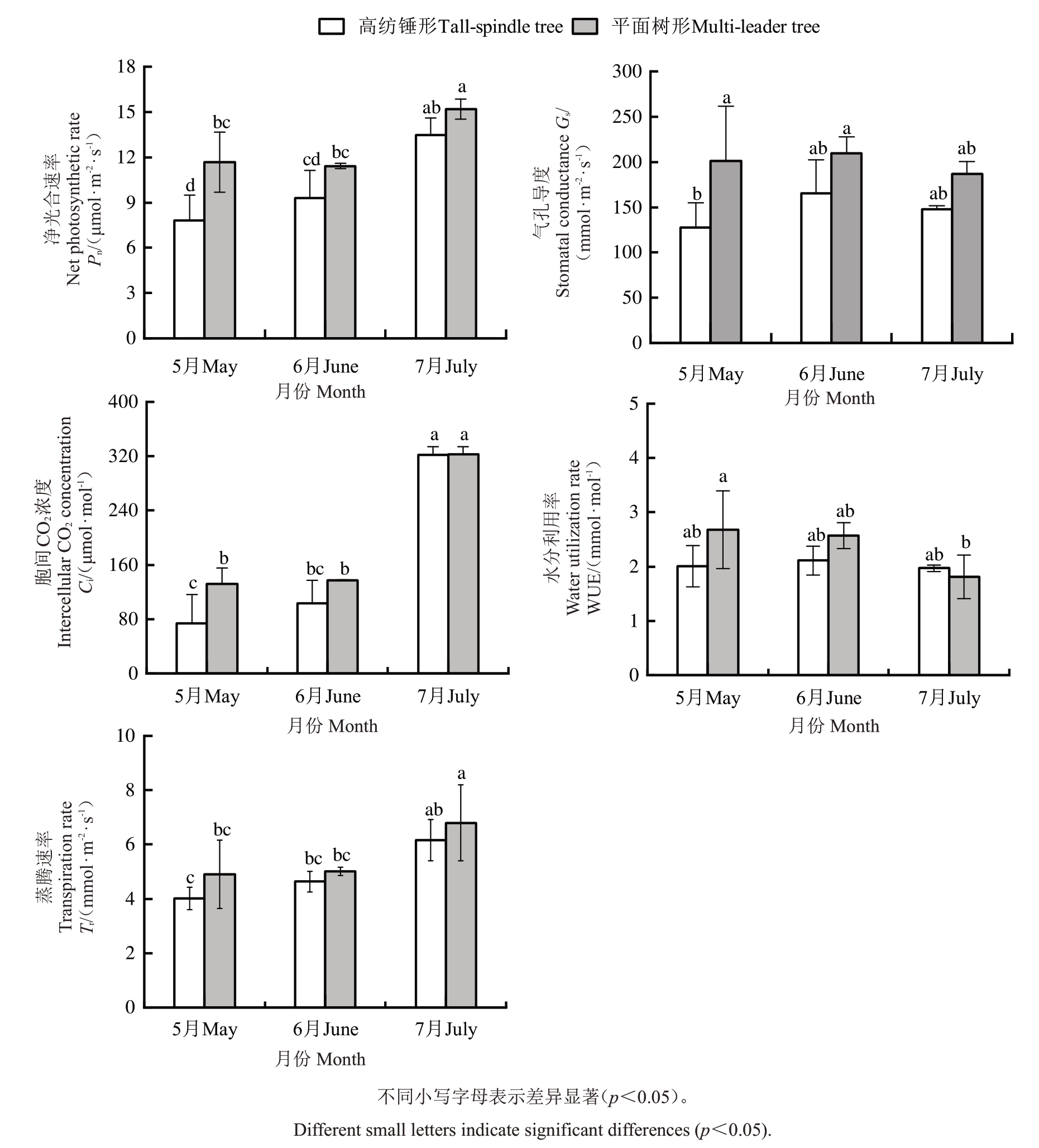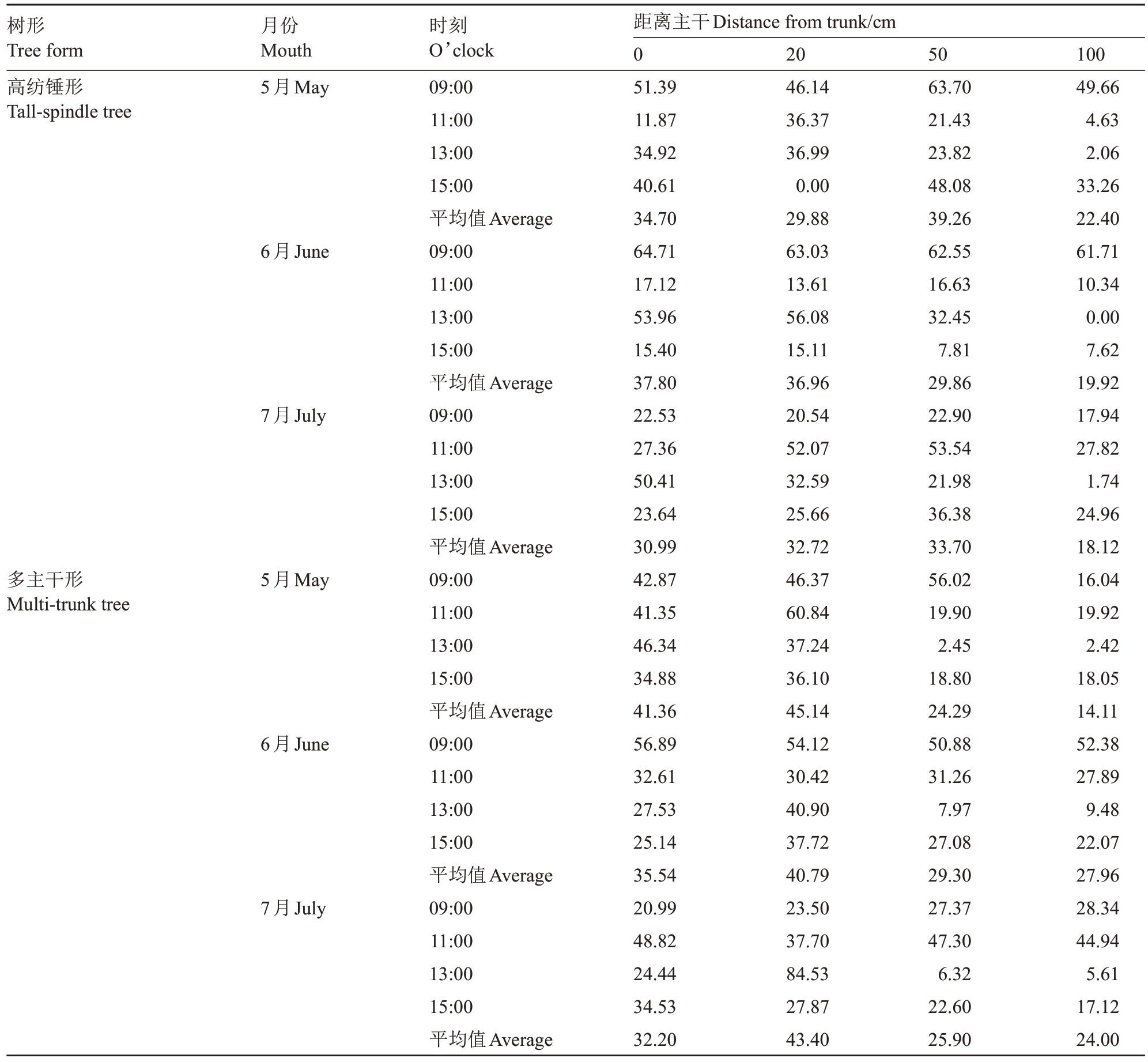中国是世界第一苹果生产大国,苹果是我国具有明显国际竞争力的农产品之一[1]。实现苹果产业高质量发展,对增加果农收入、促进脱贫致富、实现乡村振兴具有重要意义[2-3]。近年来,苹果矮砧密植集约栽培成为新植果园主要发展模式。高光效树形,尤其是高纺锤形得到了大面积的推广,与传统大冠稀植模式相比,其具有易管理、结果早、产量高、优果率高等优点[4]。近年来,该种植模式遇到系列技术瓶颈,主要是树冠为三维立体(3D)结构,冠层较厚,果实随机分布,修剪及果实采摘难以实现机械化;同时,由于行间需要留有机器作业道,种植密度无法加大。随着社会经济的发展,劳动力紧缺已成为常态,未来果园管理全面实现机械化,减少人力投入是必由之路。二维(2D)平面树形可实现机械化作业,充分利用空间及光能,进一步提高产量,减少人工,是未来果园管理的发展趋势,有助于实现果业的现代化和可持续发展。
我国在近30年里先后建立了乔砧稀植栽培、乔砧密植栽培以及矮砧集约栽培技术体系[5]。如何使苹果树冠结构更简化,为全面机械化、智能化管理打好基础,科学家开始研究以2D平面结果为核心的未来果园生产系统,多主干形是2D 平面树形中的一种,与Dorigoni 等[6]提到的Simple Guyot 树形类似,主干弯曲向一侧延伸,主干上每隔30 cm 留直立向上结果枝条(主干)5~6 个。枝条及果实平面分布,行距由3.5~4 m 减小至2~2.5 m,整体冠层光利用率提高,可突破现有果园产量瓶颈,实现果园管理及果实采收的智能机械化。Tustin 等[7]指出双边多主干平面树形在种植后的第2年和第3年就表现出了显著的早期生产力,除了光拦截率,调节年度生长资源分配到果实生长的过程也是决定苹果园生产潜力的重要因素。Dorigoni 等[8]深入讨论了Guyot 树形的二维结构及没有二级分枝的特点,可以选择单行和双行两种种植模式,强调了该树形适应机械化方面的潜力,包括修剪、疏果和除草等。Bortolotti等[9]的研究表明Guyot树形的直立生长枝即主干不应被视为彼此独立的单元,需要对每个主干进行精确的负载控制,以实现精准果园管理。Tustin等[10]的研究表明,通过优化行间距和树形结构,可以显著提高苹果园的光能利用率和生产力,而且现有苹果的生产潜力可能被低估。Robinson[11]的研究表明苹果园的产量与光拦截相关,还指出可以通过增加树冠中的叶片密度、改变树形、增加树高与行距的比例或使用反光膜在地面上增加光拦截。曾艳鑫等[12]在2024 年利用多主干树形的苹果研究了不同砧木对树形生长和果实品质的影响。史继东[13-14]介绍了这种单边多主干形的栽培方法。
这种新树形的研究工作虽然开始时间不长,但是已经展现了良好的前景和巨大的生产潜力。目前我国在这方面的研究只开展了部分零星的工作。本研究着眼于未来果园发展趋势,围绕宜机化种植、简约化管理的苹果2D树形管理模式,以高纺锤形为对照,开展苹果多主干形产量和品质研究及生产潜力与应用评价,将为未来苹果园建设打好基础,为苹果产业高质量发展做出贡献。
1 材料和方法
1.1 试验材料
试验在中国农业科学院郑州果树研究所果树栽培课题组试验园(113°42'44" E、34°42'45" N)中进行,试材为优良早熟品种华硕/M9T337。嫁接苗于2021年春定植,定植后通过拉枝使新生主枝沿着行向生长,在其上每隔30 cm 留一个直立向上的枝条(主干),再经过2022年的生长,共留5~6个主干,树形基本形成,2022年零星挂果,2023年完全成形,初步丰产。高纺锤形和多主干形的株行距分别为1.5 m×3.5 m、1.5 m×2.5 m。试验园常规管理。
1.2 试验设计
选取长势一致、有代表性的两种树形植株各3株,单株重复,从果实生长发育开始(4 月初开花,4月10日左右落花,果实发育期110 d左右,花后10 d开始第一次测定),在果实生长期,分别在5、6、7 月测定叶片光合参数、叶片面积、SPAD值及光截获率等。成熟期每棵树随机采摘15 个果实进行单果质量、纵横径、硬度、可溶性固形物含量、可滴定酸含量等品质指标的测定。采果后,调查树体生长、枝(梢)类组成,测算生长量。根据单株产量及栽植密度,计算666.7 m2产量。2023 年和2024 年对果实品质及树体结构参数进行重复测定。
1.3 测定项目及方法
1.3.1 果实品质测定 用电子游标卡尺(16FN,MAHR,德国)测量果实纵、横径,果形指数=果实纵径/果实横径。用电子天平(E5500S,Sartorius,德国)测量单个果实质量。果实硬度采用数显水果硬度计(GY-4-J,托普仪器)测定,硬度计探头直径为0.8 cm,每果测3次,取平均值。采用数显式糖度计(PAL-1,ATAGO,日本)测量可溶性固形物含量,可滴定酸含量用酸度计(GMK-835N,G-WON,韩国)测定。
1.3.2 叶片相关指标测定 在各试验树树冠外围中部随机选取长中短梢各10条,用LI-3000C便携式叶面积仪(美国LI-COR公司生产,分辨率为1 mm2)测量新梢上的单叶片面积,并累加得到单梢叶面积,以每类新梢平均单梢叶面积乘以该类新梢数再相加得到试验树的总叶面积,据此求得叶面积指数等相关指标。于5、6、7月中上旬取枝条中部健康成熟完整叶片进行光合指标、叶绿素指标测定,每个重复取10枚叶片。叶绿素含量采用SPAD-502叶绿素仪测定。光合指标在晴天上午09:00—11:00,用美国PP System公司的CIRAS-3便携式光合仪测定。
1.3.3 冠层不同位置光截获率 用TSE-1332 型数字式照度计,于5、6、7月选择晴天,每天测量时间为09:00、11:00、13:00、15:00,每月测定3 d。每次在距树干0、20、50、100 m 处的固定位置(1.5 m 高度)测定光照度,在主干处距地面0、20、50、100、150 cm高度测定光照度。以3 d 的测量数据平均值为叶幕形成期不同层次的光照度值。冠内及冠下的光照度值与冠层上方的光照度值的比值即为冠层的透光率,以百分比计,冠层的光截获率/%=(1-冠层透光率)×100[15]。
1.3.4 树体结构调查 采摘前(每年8月上旬)调查树体枝梢类组成情况,按长度划分:长枝,>30.0 cm;中枝,15~30.0 cm;短枝,<15.0 cm。干高:主干高度,用卷尺测量从地表到主枝基部的距离。干径:树干距地面10 cm 处,用游标卡尺测量树干的粗度。树高:用标杆、卷尺测量从地表到树冠最高点的距离。主枝粗度:用游标卡尺测量主枝基部5 cm的粗度。采果后统计枝量,调查各树形整株果树的干高、干径、主枝数、主枝粗、枝类(长枝、中枝、短枝)的数量。
1.4 数据分析
使用Excel 整理试验数据和作图,利用SPASS 19.0进行方差分析。
2 结果与分析
2.1 两种树形果实品质分析
测定了2023 年和2024 年两种不同树形果实相关品质指标,两年结果相似度较高(表1)。两种树形的单果质量接近,多主干形的果形指数低于高纺锤形,但未达到显著差异水平,说明两种树形的果实生长比较接近。2023 年高纺锤树形的果实硬度平均值是9.30 kg·cm-2,而多主干形只有7.10 kg·cm-2;2024 年依然是高纺锤形果实硬度高,但未达到显著性差异,标准差可以看出高纺锤形果实硬度差异较大。两年的数据显示,多主干形果实的可溶性固形物含量高于高纺锤形,可滴定酸含量低于高纺锤形果实,但都未达到显著差异水平,说明两种高光效树形的果实风味差异不大。
表1 2023 和2024 年两种树形果实品质比较
Table 1 Comparison of fruit quality of two tree forms in 2023 and 2024

年份Year 2023 2024树形Tree form高纺锤形Tall-spindle tree多主干形Multi-trunk tree高纺锤形Tall-spindle tree多主干形Multi-trunk tree单果质量Single fruit mass/g 247.63±29.78 246.84±21.50 246.67±25.58 244.33±12.01横径Transverse diameter/mm 81.28±4.55 82.90±5.60 81.13±4.80 81.53±3.59纵径Longitudinal diameter/mm 63.63±4.02 70.25±5.66 64.00±6.24 70.33±2.08果形指数Shape index of fruit 0.78±0.04 0.85±0.05 0.79±0.04 0.86±0.06硬度Hardness/(kg·cm2)9.30±1.67 7.10±1.42 9.00±1.77 8.10±1.52 w(可溶性固形物)Total soluble solid content/%12.21±0.90 13.45±0.71 12.41±0.50 13.86±0.51 w(可滴定酸)Titratable acid content/%0.31±0.04 0.27±0.06 0.30±0.05 0.26±0.03
2.2 两种树形叶片光合性能分析
通过两种树形光合参数的比较,发现相同时间多主干形的净光合速率(Pn)、胞间二氧化碳浓度(Ci)、气孔导度(Gs)都高于高纺锤形,但只在5 月份时差异显著,在6月和7月时差异不显著(图1)。两种树形的蒸腾速率(Tr)从5月到7月都是逐渐升高,但每个月份两者之间没有显著差异。相同时间两种树形水分利用率没有显著差异,多主干形水分利用率从5月到7月逐渐降低。

图1 两种树形5—7 月的气体交换参数比较
Fig.1 Comparison of gas exchange parameters between two tree forms from May to July
2.3 两种树形叶面积及SPAD值
测定了两种树形在果实生长期的叶片面积变化及相对叶绿素含量(表2)。高纺锤形的叶片总面积显著高于多主干形,最大的是7 月份达到了91 120.12 cm2,而多主干形最大的也是7 月份只有58 805.66 cm2;高纺锤形的叶面积指数5 月份为1.74,6月份为1.86,7月份为2.02,多主干形5、6、7月分别为1.15、1.29和1.57,显著低于高纺锤形。说明高纺锤形叶片密度大、光合潜力大,也说明可能遮挡严重。两种树形的SPAD值从5月到7月逐渐升高,说明叶片叶绿素含量逐渐增加,相同月份两种树形之间SPAD值没有显著差异。
表2 两种树形叶面积及SPAD 值
Table 2 Leaf area and SPAD value of two types of tree forms

注:同一列中不同小写字母表示在0.05 水平差异显著。下同。
Note:Different small letters in the same column indicate significant differences at p<0.05.The same below.
树形Tree form高纺锤形Tall spindle tree多主干形Multicentric stem tree SPAD 50.58±1.98 bc 52.83±0.96 b 57.56±0.29 a 50.21±0.39 c 52.77±1.43 b 58.48±1.68 a月份Mouth 5月May 6月June 7月July 5月May 6月June 7月July总叶片面积Total blade area/cm2 78 161.43 ab 83 625.96 ab 91 120.12 a 43 273.60 b 48 302.24 ab 58 805.66 ab叶面积指数Leaf area index 1.74 ab 1.86 ab 2.02 a 1.15 b 1.29 ab 1.57 ab
2.4 两种树形光截获率比较
研究发现,两种树形的光截获率基本上呈随地面高度增大而减小的趋势,高纺锤形于地面高度1 m以下时的光截获率较高,3 m 时的光截获率显著降低(表3)。多主干形基本也呈现出类似的趋势,但是树底部和上部的光截获率差别没有高纺锤形差别大。多主干形1 m以上光截获率基本达到了50%以下,说明透光率较高。整体上看,多主干形的光截获率要低于高纺锤形,说明多主干形透光率较高,内部遮挡较轻。从09:00—11:00,两种树形的光截获率没有表现出明显的规律性,到13:00时,高纺锤形光截获率数值整体偏高,说明此时上部叶片对下部造成了遮挡。15:00 时,两种树形的透光率都较高,尤其是6、7月份。
表3 两种树形不同冠层高度光截获率比较
Table 3 Comparison of light interception rate of two tree shapes with different canopy heights %

时刻O’clock 09:00 11:00 13:00 15:00与地面高度Height to ground/m 0.5 1.0 1.5 2.0 2.5 3.0 0.5 1.0 1.5 2.0 2.5 3.0 0.5 1.0 1.5 2.0 2.5 3.0 0.5 1.0 1.5 2.0 2.5 3.0 5月May高纺锤形Tall-spindle tree 80.52 81.91 51.39 17.42 41.25 25.99 79.22 50.44 11.87 55.14 9.62 11.31 65.24 91.55 34.92 62.67 27.40 4.34 91.31 70.22 40.61 52.42 55.62 21.32多主干形Multi-trunk tree 25.87 27.30 42.87 20.66 20.56 29.59 33.98 30.13 41.35 4.07 3.46 11.44 58.87 22.01 46.34 1.30 2.88 5.33 64.00 84.28 34.88 37.84 16.96 0.00 6月June高纺锤形Tall-spindle tree 76.80 75.11 64.71 64.95 63.51 58.96 79.44 28.70 17.12 9.28 61.01 34.25 83.85 76.45 53.96 68.23 43.25 8.68 52.61 17.61 15.40 8.96 3.58 26.55多主干形Multi-trunk tree 44.07 41.74 56.89 44.87 39.90 21.29 48.63 41.21 32.61 32.69 32.02 24.01 52.13 49.47 27.53 17.37 18.52 32.01 6.34 40.90 25.15 40.59 0.00 18.71 7月July高纺锤形Tall-spindle tree 75.77 37.06 22.53 19.30 30.60 28.12 78.06 36.30 27.36 42.29 47.09 25.24 93.93 90.38 50.41 44.39 25.96 4.27 48.51 23.64 23.64 17.84 1.76 0.00多主干形Multi-trunk tree 55.13 49.32 20.99 17.60 14.89 2.80 64.97 74.79 71.67 45.77 8.76 0.00 87.75 25.00 64.01 57.50 30.10 3.53 35.93 27.47 34.53 13.94 21.60 5.18
两种树形离主干1.5 m 高度、不同远处(0、20、50、100 cm)的光截获率的测定结果表明(表4),距离主干越远光截获率越低。不同月份间的光截获率没有表现明显规律。5 月份时,高纺锤形在距离主干0 和20 cm 的光截获率低于多主干形,在50 和100 cm处高于多主干形;6月份时,高纺锤形在距离主干20和100 cm的光截获率低于多主干形,在0和50 cm处高于多主干形;7月份时,除了50 cm处高于多主干形外,其他距离都低于多主干形。总体来看,距离主干不同距离两种树形的平均光截获率都较低,说明主干1.5 m高度不同冠幅距离的光照较为充足,叶片遮挡较轻。
表4 两种树形果实生长期树干1.5 m 高度不同远度的光截获率
Table 4 Light interception rate of different distances at 1.5 m height of trunk during fruit growth period of two tree forms%

树形Tree form高纺锤形Tall-spindle tree月份Mouth 5月May 6月June 7月July多主干形Multi-trunk tree 5月May 6月June 7月July时刻O’clock 09:00 11:00 13:00 15:00平均值Average 09:00 11:00 13:00 15:00平均值Average 09:00 11:00 13:00 15:00平均值Average 09:00 11:00 13:00 15:00平均值Average 09:00 11:00 13:00 15:00平均值Average 09:00 11:00 13:00 15:00平均值Average距离主干Distance from trunk/cm 0 51.39 11.87 34.92 40.61 34.70 64.71 17.12 53.96 15.40 37.80 22.53 27.36 50.41 23.64 30.99 42.87 41.35 46.34 34.88 41.36 56.89 32.61 27.53 25.14 35.54 20.99 48.82 24.44 34.53 32.20 20 46.14 36.37 36.99 0.00 29.88 63.03 13.61 56.08 15.11 36.96 20.54 52.07 32.59 25.66 32.72 46.37 60.84 37.24 36.10 45.14 54.12 30.42 40.90 37.72 40.79 23.50 37.70 84.53 27.87 43.40 50 63.70 21.43 23.82 48.08 39.26 62.55 16.63 32.45 7.81 29.86 22.90 53.54 21.98 36.38 33.70 56.02 19.90 2.45 18.80 24.29 50.88 31.26 7.97 27.08 29.30 27.37 47.30 6.32 22.60 25.90 100 49.66 4.63 2.06 33.26 22.40 61.71 10.34 0.00 7.62 19.92 17.94 27.82 1.74 24.96 18.12 16.04 19.92 2.42 18.05 14.11 52.38 27.89 9.48 22.07 27.96 28.34 44.94 5.61 17.12 24.00
2.5 两种树形树体结构参数比较
两种树形,从2023到2024年主干粗度都有所增加,树高无显著差异(表5)。高纺锤形两年的主枝数量都是21 个左右,主枝长度平均值有所降低,但两年数据未达到显著差异水平。多主干形只有5个直立主干,两年主干高无显著差异。2023 年两种树形不同长度枝条的数量较为接近,到2024年两种树形都是长枝和短枝变多,中枝减少。高纺锤形和多主干形长枝的数量分别由30和27个增长到了51和57 个,中枝数量由22 和23 个减少到了13 和9 个,短枝由32和37个增加到了79和59个。高纺锤形的株行距按1.5 m×3.5 m 计算,每公顷定植株数为1904株;多主干形按1.5 m×2.5 m计算,每公顷定植株数为2666 株。2024 年单株平均挂果数和产量均高于2023 年。多主干形每公顷产量为26.76 t 和27.79 t,比高纺锤形多6~7 t。
表5 2023、2024 年两种树形结构参数及产量
Table 5 Two tree structure parameters and yields in 2023 and 2024

产量Yield/(t·hm-2)20.59 26.76 20.67 27.79定顷数er of m2公株每植Numb settled plants per h 0419662604196626数its果挂Number of fru 43.66±3.21 40.66±5.13 44.00±3.60 42.67±9.71量(<数短15 cm)枝Number of short branches 15 cm)42.67±15.04 47.33±10.69 79.33±10.79 59.00±17.00-(<(15~量id cm)枝cm)中30Numb数er of m dle branches 5-307±7±0±(1.6227.51.6237.51.0134.009.00±1.00量(>数枝mber of 30 cm)长30 cm)Nu long branches(>30.00±2.00 27.67±9.87 51.00±24.63 57.00±7.00-度粗eter 5±0±干主Diam of the cen tral trunk/mm-201.03.6-242.35.1度高0 0干9.78±.36.10±.2主Center Trunkht/heig cm-1813-1713数er个tral主Numb干of cens stem-5.00-5.00度ess粗枝主Thicknain/of m branch mm16.60±0.80-17.79±0.89-度长branchth主Main /3±5枝leng cm1011.63-9312-2.95±主50 cm).0.5量(>数枝Number of main branch 50 cm)(>21.00±1.00-21.33±0.58-度粗干主Trunketer/diam mm37.98±2.95 39.02±3.15 48.33±4.16 46.67±5.13度主Trunkht/高干heig cm655.00.0 0±7±.6665.770±655.00.07±.6665.77高Treeht/cm325.33±±±±树heig 8.50 314.53 2.20 336.33 8.50 340.33 26.50形Tree form多Multi-trun k形高Tall-spindle形k形形tree锤干锤干纺纺tree主主树高Tall-spindle tree多Multi-trun tree年份Year 2023 2024
3 讨 论
3.1 苹果冠层光分布与产量品质的关系
冠层光截获率与果实产量密切相关,研究表明60%~70%的季节性有效光拦截率是成熟苹果园的实际上限,而对于目前大面积推广的种植系统冠层而言光截获率并不是越高越好,超过一定比例,就意味着枝叶产生了重叠遮挡,透光率太低,果实品质会受到较大影响[16]。Palmer 等[17]通过对新西兰苹果种植系统的研究,推断其晚熟品种产量对光拦截的响应,如果光拦截率能达到90%,理论上能达到较高的产量。这就需要对种植系统进行革命性的重新设计,包括简化树形结构和管理方式,以及提高光拦截效率。
对于传统大冠树形,叶片遮挡严重,内膛无效区域较大,树冠外围光照好,果实品质好,内膛果实品质差;高纺锤形树形树冠变小,几乎没有内膛无效区,但枝叶上下遮挡情况仍存在,行间也存在互相遮挡的问题;平面树形应运而生,其所有的枝条果实都分布在平面上,光照分布均匀,由于冠层较薄,光线甚至可以透过行间,因此,平面树形理论上光分布和果实品质最均匀。本试验结果也证明了这一点,相比于高纺锤形,多主干平面树形与地面不同高度的光截获率变化幅度较为接近,同一高度不同远处的光截获率变化幅度也较小。至于部分光截获率出现了上部高于下部的情况,这是由于果园树体的遮挡及不同时间太阳照射方位不一导致,但并不影响对整体光截获率的分析。生产力的限制因素包括生长环境中光能的季节性可用性,以及种植系统对该能量的最大捕获效率。研究表明,传统的大冠树形果园系统设计在捕获更高比例光能的能力上受到限制,无法将光能有效地转化为作物产量[17]。最高效的现代果园种植系统未能利用30%~40%的可用光能[16]。这就需要对现有的树形结构进行改革,以捕获和利用更多的光能。多主干平面树形冠层薄、行距窄,能更好地利用单位面积的光能;同时,由于冠层薄,底部互相遮光轻,树高可以进一步增加,充分利用上层空间,将会进一步提高生产力。
3.2 平面树形增产潜力分析
苹果产量不仅与冠层的光截获关系密切[18],还与近果实中短果枝的光截获相关。相较于高纺锤形等立体结果树形,平面树形极大地简化了树体结构,用于枝干建造的营养物质明显减少,光合产物分配到果实上的比例更高。虽然平面树形的株行距小于高纺锤形,但是每公顷株数大大提高,产量大幅度提升,对于平面树形,应更注重其每公顷的结果枝数,而不是每公顷的株数,前者与产量关系更密切。平面树形的主枝数量少,生长更为均一,长枝数量少,短枝数量多,有更大的潜力用于果实生长。本研究中,2024 年多主干形长枝数量较2023 年显著增多,中枝增长成为了长枝,但短枝数量也有所增加,这可能与修剪有关。然而,两种树形2024年的产量并没有比2023 年大幅度提升,有两方面原因,一是疏花疏果较为严格,二是病虫害防治出现问题,特别是橘小实蝇未能有效防治,加上鸟啄、日灼等导致落果较多,影响了最终产量。
影响Pn因素有气孔限制和非气孔限制两方面,5月份时,多主干形的Pn显著高于高纺锤形,而Gs也是多主干形显著高于高纺锤形,可见是气孔限制的原因,多主干形可以更好地进行光合作用。这可能是由于5 月份时太阳高度角低、多主干形的叶片都可以接受光照,可以较好地进行光合作用。总体来说,多主干形的光合性能要强于高纺锤形,这也可能是多主干形产量高的原因之一。
3.3 平面树形生产应用前景
与高纺锤形等传统树形相比,平面树形冠层更薄,单位结果枝更多,产量更高,果实分布更均匀,品质更均一,利于机械化修剪和采摘[8]。投入方面,苗木、支架等设施投入与高纺锤形基本相同。树形的塑造上,多主干形第一年树形的塑造大约每公顷需要花费250 h 的人工[6],第一年的树木培养必须逐步进行,在春季和夏季进行5~10 次干预,但是一旦成形,进行机械化管理就会省时省力[19]。相比于高纺锤形的“生产重心”趋向于向上和向外移动问题,多主干平面形有多个垂直生长的主干,有效分散了生长势,树体整体生长更加平衡。本研究中的多主干形有5~6 个结果主干,且由于是单边多主干形,株距缩减为1.5 m,每公顷种植株数远远多于高纺锤形,在果实大小和品质没有显著差异的情况下,产量有所提升。因此,整体上来看,其是适于未来果园应用的良好树形。但是,在不同地区、不同砧木品种上的应用效果如何,还需要进行持续试验验证。
4 结 论
多主干形虽然前期在树形塑造上较高纺锤形有难度,但是果实品质较好,光合性能优于高纺锤形,且产量有所提升,多主干形易管理是实现机械化、精准化、数字化的理想树形。
[1] 赵德英.国内外苹果栽培模式的变革[J].果树实用技术与信息,2023(1):45-46.ZHAO Deying. The transformation of apple cultivation models both domestically and internationally[J]. Practical Techniques and Information for Fruit Trees,2023(1):45-46.
[2] 邓秀新,束怀瑞,郝玉金,徐强,韩明玉,张绍铃,段常青,姜全,易干军,陈厚彬.果树学科百年发展回顾[J].农学学报,2018,8(1):24-34.DENG Xiuxin,SHU Huairui,HAO Yujin,XU Qiang,HAN Mingyu,ZHANG Shaoling,DUAN Changqing,JIANG Quan,YI Ganjun,CHEN Houbin. Review on the centennial development of pomology in China[J]. Journal of Agriculture,2018,8(1):24-34.
[3] 束怀瑞,张世忠.我国苹果产业70 年发展历程与展望[J].落叶果树,2021,53(1):1-3.SHU Huairui,ZHANG Shizhong. The 70 years’development and prospect of apple industry in China[J]. Deciduous Fruits,2021,53(1):1-3.
[4] 杜海平. 苹果现代栽培模式与关键配套技术[J]. 农机市场,2024(7):61-63.DU Haiping. Modern cultivation mode and key supporting technology of apple[J].Agricultural Machinery Market,2024(7):61-63.
[5] 王田利.苹果栽培模式和树形[J].北方果树,2020(4):31-32.WANG Tianli.Apple cultivation mode and tree shape[J]. Northern Fruits,2020(4):31-32.
[6] DORIGONI A,MICHELI F. Guyot training:A new system for producing apples and pears[J]. European Fruit Magazine,2018,2:18-23.
[7] TUSTIN D S,VAN HOOIJDONK B M,BREEN K C.The Planar Cordon-New planting systems concepts to improve light utilisation and physiological function to increase apple orchard yield potential[J].Acta Horticulturae,2018(1228):1-12.
[8] DORIGONI A,MICHELI F. Development of a cultivation system for multi-leader trees[J].European Fruit Magazine,2019,5:8-13.
[9] BORTOLOTTI G,PERULLI G,BOINI A,BRESILLA K,BONORA A,VENTURI M,MANFRINI L. Individual upright physiological traits in an apple“Guyot”training system[J].Acta Horticulturae,2022(1346):353-358.
[10] TUSTIN D S,BREEN K C,VAN HOOIJDONK B M. Light utilisation,leaf canopy properties and fruiting responses of narrow-row,planar cordon apple orchard planting systems:A study of the productivity of apple[J]. Scientia Horticulturae,2022,294:110778.
[11] ROBINSON T L.The physiological basis of orchard system performance with respect to light interception and light conversion efficiency[J].Acta Horticulturae,2022(1346):207-218.
[12] 曾艳鑫,宫昊楠,由春香,卢景生,高文胜,王小非.不同砧木对多主干树形‘瑞香红’苹果幼树树体生长及果实品质的影响[J].中国农业科学,2024,57(14):2847-2861.ZENG Yanxin,GONG Haonan,YOU Chunxiang,LU Jingsheng,GAO Wensheng,WANG Xiaofei. Effects of different rootstocks on growth and fruit quality of young Ruixianghong apple trees with multi-stem shape[J].Scientia Agricultura Sinica,2024,57(14):2847-2861.
[13] 史继东.苹果古优特(Guyot)栽培法(上)[J].西北园艺,2023(12):1-4.SHI Jidong. Cultivation method of apple Guyot (Ⅰ)[J]. Northwest Horticulture,2023(12):1-4.
[14] 史继东.苹果古优特(Guyot)栽培法(下)[J].西北园艺,2024(2):1-4.SHI Jidong. Cultivation method of apple Guyot (Ⅱ)[J]. Northwest Horticulture,2024(2):1-4.
[15] 高登涛,郭景南,魏志峰,范庆锦,杨朝选.中部地区两类矮砧密植苹果园生产效率及光照质量评价[J]. 中国农业科学,2012,45(5):909-916.GAO Dengtao,GUO Jingnan,WEI Zhifeng,FAN Qingjin,YANG Chaoxuan. Evaluation of productivity and light quality in two high density dwarf rootstock apple orchards in Central China[J].Scientia Agricultura Sinica,2012,45(5):909-916.
[16] TUSTIN D S.Future orchard planting systems-Do we need another revolution?[J].Acta Horticulturae,2014,1058:27-36.
[17] PALMER J W,WÜNSCHE J N,MELAND M,HANN A.Annual dry-matter production by three apple cultivars at four withinrow spacings in New Zealand[J]. The Journal of Horticultural Science and Biotechnology,2002,77(6):712-717.
[18] 赵先飞,张馨予,于国康,梁洁,赵紫嫣,刘宇,张林森.短枝富士苹果不同负载和灌水量对新梢生长、产量和灌水利用效率的影响[J].果树学报,2023,40(9):1860-1870.ZHAO Xianfei,ZHANG Xinyu,YU Guokang,LIANG Jie,ZHAO Ziyan,LIU Yu,ZHANG Linsen. Effect of different fruit loads and irrigation amounts on new shoot growth,yield and irrigation water use efficiency in spur-type Fuji apples[J]. Journal of Fruit Science,2023,40(9):1860-1870.
[19] ZHANG Qin.Automation in tree fruit production:Principles and practice[M].Watlington:CABI,2018:85-88.